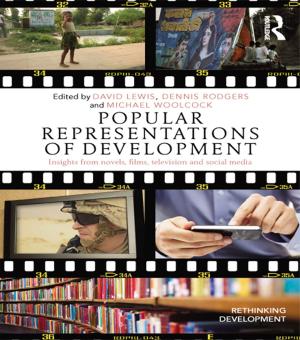Urban Revitalization
Remaking cities in a changing world
Nonfiction, Art & Architecture, Architecture, Planning, Science & Nature, Science, Earth Sciences, Geography, Social & Cultural Studies, Social Science, Human Geography| Author: | Carl Grodach, Renia Ehrenfeucht | ISBN: | 9781317912019 |
| Publisher: | Taylor and Francis | Publication: | December 22, 2015 |
| Imprint: | Routledge | Language: | English |
| Author: | Carl Grodach, Renia Ehrenfeucht |
| ISBN: | 9781317912019 |
| Publisher: | Taylor and Francis |
| Publication: | December 22, 2015 |
| Imprint: | Routledge |
| Language: | English |
Following decades of neglect and decline, many US cities have undergone a dramatic renaissance. From New York to Nashville and Pittsburgh to Portland governments have implemented innovative redevelopment strategies to adapt to a globally integrated, post-industrial economy and cope with declining industries, tax bases, and populations. However, despite the prominence of new amenities in revitalized neighborhoods, spectacular architectural icons, and pedestrian friendly entertainment districts, the urban comeback has been highly uneven. Even thriving cities are defined by a bifurcated population of creative class professionals and a low-wage, low-skilled workforce. Many are home to diverse and thriving immigrant communities, but also contain economically and socially segregated neighborhoods. They have transformed high-profile central city brownfields, but many disadvantaged neighborhoods continue to grapple with abandoned and environmentally contaminated sites. As urban cores boom, inner-ring suburban areas increasingly face mounting problems, while other shrinking cities continue to wrestle with long-term decline. The Great Recession brought additional challenges to planning and development professionals and community organizations alike as they work to maintain successes and respond to new problems. It is crucial that students of urban revitalization recognize these challenges, their impacts on different populations, and the implications for crafting effective and equitable revitalization policy. Urban Revitalization: Remaking Cities in a Changing World will be a guide in this learning process.
This textbook will be the first to comprehensively and critically synthesize the successful approaches and pressing challenges involved in urban revitalization. The book is divided into five sections. In the introductory section, we set the stage by providing a conceptual framework to understand urban revitalization that links a political economy perspective with an appreciation of socio-cultural factors in explaining urban change. Stemming from this, we will explain the significance of revitalization and present a summary of the key debates, issues and conflicts surrounding revitalization efforts. Section II will examine the historical causes for decline in central city and inner-ring suburban areas and shrinking cities and, building from the conceptual framework, discuss theory useful to explain the factors that shape contemporary revitalization initiatives and outcomes. Section III will introduce students to the analytical techniques and key data sources for urban revitalization planning. Section IV will provide an in-depth, criticaldiscussion of contemporary urban revitalization policies, strategies, and projects. This section will offer a rich set of case studies that contextualize key themes and strategic areas across a range of contexts including the urban core, central city neighborhoods, suburban areas, and shrinking cities. Lastly, Section V concludes by reflecting on the current state of urban revitalization planning and the emerging challenges the field must face in the future.
Urban Revitalization will integrate academic and policy research with professional knowledge and techniques. Its key strength will be the combination of a critical examination of best practices and innovative approaches with an overview of the methods used to understand local situations and urban revitalization processes. A unique feature will be chapter-specific case studies of contemporary urban revitalization projects and questions geared toward generatingclassroom discussion around key issues. The book will be written in an accessible style and thoughtfully organized to provide graduate and upper-level undergraduate students with a comprehensive resource that will also serve as a reference guide for professionals
Following decades of neglect and decline, many US cities have undergone a dramatic renaissance. From New York to Nashville and Pittsburgh to Portland governments have implemented innovative redevelopment strategies to adapt to a globally integrated, post-industrial economy and cope with declining industries, tax bases, and populations. However, despite the prominence of new amenities in revitalized neighborhoods, spectacular architectural icons, and pedestrian friendly entertainment districts, the urban comeback has been highly uneven. Even thriving cities are defined by a bifurcated population of creative class professionals and a low-wage, low-skilled workforce. Many are home to diverse and thriving immigrant communities, but also contain economically and socially segregated neighborhoods. They have transformed high-profile central city brownfields, but many disadvantaged neighborhoods continue to grapple with abandoned and environmentally contaminated sites. As urban cores boom, inner-ring suburban areas increasingly face mounting problems, while other shrinking cities continue to wrestle with long-term decline. The Great Recession brought additional challenges to planning and development professionals and community organizations alike as they work to maintain successes and respond to new problems. It is crucial that students of urban revitalization recognize these challenges, their impacts on different populations, and the implications for crafting effective and equitable revitalization policy. Urban Revitalization: Remaking Cities in a Changing World will be a guide in this learning process.
This textbook will be the first to comprehensively and critically synthesize the successful approaches and pressing challenges involved in urban revitalization. The book is divided into five sections. In the introductory section, we set the stage by providing a conceptual framework to understand urban revitalization that links a political economy perspective with an appreciation of socio-cultural factors in explaining urban change. Stemming from this, we will explain the significance of revitalization and present a summary of the key debates, issues and conflicts surrounding revitalization efforts. Section II will examine the historical causes for decline in central city and inner-ring suburban areas and shrinking cities and, building from the conceptual framework, discuss theory useful to explain the factors that shape contemporary revitalization initiatives and outcomes. Section III will introduce students to the analytical techniques and key data sources for urban revitalization planning. Section IV will provide an in-depth, criticaldiscussion of contemporary urban revitalization policies, strategies, and projects. This section will offer a rich set of case studies that contextualize key themes and strategic areas across a range of contexts including the urban core, central city neighborhoods, suburban areas, and shrinking cities. Lastly, Section V concludes by reflecting on the current state of urban revitalization planning and the emerging challenges the field must face in the future.
Urban Revitalization will integrate academic and policy research with professional knowledge and techniques. Its key strength will be the combination of a critical examination of best practices and innovative approaches with an overview of the methods used to understand local situations and urban revitalization processes. A unique feature will be chapter-specific case studies of contemporary urban revitalization projects and questions geared toward generatingclassroom discussion around key issues. The book will be written in an accessible style and thoughtfully organized to provide graduate and upper-level undergraduate students with a comprehensive resource that will also serve as a reference guide for professionals















